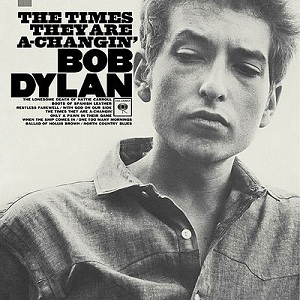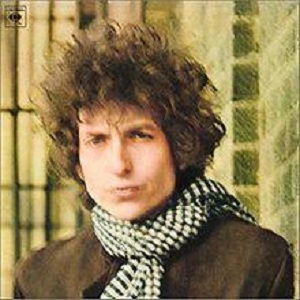Last time, I talked you through the albums of David Bowie. As I mentioned in that article, once I “got” him, Dylan essentially displaced Bowie as the key love in my life of music fandom. Unlike Bowie, it was not love at first sight. There were some initial hurdles to overcome: I’d been used to listening to well-produced studio albums from the 1970s, so when I first tried to get into Dylan he seemed totally unlike anything I’d encountered before. His voice is unorthodox, his songs often don’t follow the pop rules we’re all used to. If you’re a Dylan newbie reading this, then there is an acclimatisation process. I remember being 17 just about to go to university and driving in my new car (it was an old banger, a Nissan Micra) and giving Dylan another shot – I had one of those CD to tape leads that you could plug into the old cassette slot in the car. “It’s Alright Ma” came on and suddenly it all clicked and this was the greatest shit I’d ever heard in my life – like Dylan had somehow taken all my confused vague teenage notions that something wasn’t quite right with the world and articulated them perfectly. As a moment I’d almost liken it to a religious conversion, I’ve had few more profound in my life.
Unlike Bowie, who always comes across to me as being arch, calculated and impossibly cool – an intellectual artist if you want to put it that way – I’ve always thought that Dylan’s song writing is much rawer and “unschooled”. And it’s possibly for this reason, that he is probably a more “complete” artist than the Thin White Duke: he gives us every side of life, every emotion, every mood, he gets inside some of the little things in life that are difficult to put into words. Before starting, there are just two things I want to address:
First, there is the issue of Dylan’s voice. The received wisdom from non-Dylan fans, which I cringe whenever I hear is something along the lines of “He writes great songs, but he can’t sing”. I’ll just put this out there: Dylan is one of the most dynamic and engaging performers in rock history. Sure, he doesn’t have a voice like velvet, but y’know go and listen to Michael Bublé if you want that. I don’t believe that Dylan is a poet whose words you can read from the page, you need to hear them performed by him. While he doesn’t have great range in his voice, he is an incredibly emotional singer, and this makes him amazingly versatile. Just listen to something like “Ballad of a Thin Man” back-to-back with “Lay Lady Lay” to see how he can go from being snarling and contemptuous on one song to being soft, gentle and playful on another. If you can’t get past a pre-conceived notion that “Dylan can’t sing”, you might as well stop reading now.
Second, Dylan has recorded 35 studio albums to date, and beyond that there is a vast treasure trove of singles and compilation albums including, bootlegs and outtakes, some of which have been released officially, some of which haven’t. I understand that this can look off-putting to the uninitiated. I mean, where do you start? This guide is designed to try to help answer this question. But since there is so much material here, let me offer some initial “attack strategies”:
- Attack strategy 1: Begin at the beginning. This may appeal if you are a completest: just start with Bob Dylan and work forwards.
- Attack strategy 2: Start with the “holy trilogy”, then explore. If you want to beeline to what is typically considered Dylan’s “best” stuff, then start with Bringing It All Back Home, Highway 61 Revisited and Blonde on Blonde.
- Attack strategy 3: Start with Blood on the Tracks. This is one of his best and also most accessible albums, and is a great place to start. From there you could either go to Desire or move back to the 1960s.
- Advanced Attack strategy: If you are someone who has the more well-known Dylan albums but aren’t sure where to turn next, then I’d point you towards Love and Theft as being a great place to start your explorations.
Okay, enough preamble, let’s begin …
Bob Dylan (1962)
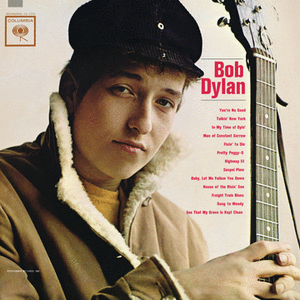
The most striking thing about Bob’s “overlooked” debut is how aggressive and full of proto-punkish energy it is. His guitar playing here is fierce. He takes a lot of these blues standards chews them up and spits them out to create something truly radical for 1962, and like nothing else released at that time at all. The highlights here are the faster numbers — “Fixin to Die” and “Highway 51 Blues”. Dylan’s own writing here is still very much in the Woody Guthrie mode, and only gives a hint of the genius that is to come. But this album establishes the fact that, as well as being the most important songwriter of the 20th century, Dylan is also arguably the most important interpreter of blues and traditional folk which would remain touchstones for the remainder of his career. A truly remarkable debut effort that deserves more time and attention.
Rating: ****
The Freewheelin’ Bob Dylan (1963)
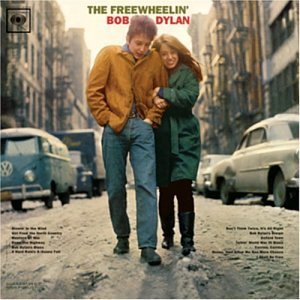
It’s almost impossible to comprehend how Bob was 21 here. This was the album that was seized upon by the zeitgeist to make Dylan “the voice of a generation”, a tag he would struggle with and come to despise in subsequent years. The front cover is one of the all-time best. The songwriting is peerless and a lesson in how to “do politics” — by staying away from specifics and yet getting at themes that seem forever apposite. “Blowin’ in the Wind” and “Masters of War” are songs that capture the mood of the early counter-culture, and also distil the political anger of youth. The towering masterpieces at the centre of this album though, are “A Hard Rain’s A-Gonna Fall”, with its pile up of vivid imagery and its driving anger and passion, the sound of the coming apocalypse, and “Don’t Think Twice, It’s Alright”, the first of many terrific break-up songs that Dylan would write. There are other songs here (e.g. “Talking World War III blues”) that are mere imitations of Woody Guthrie. Others still such as “Bob Dylan’s Dream” start to show Dylan’s more surreal side, which he would continue to explore into the mid-60s. This is an album that rests on its 5 or 6 killer songs though, which were so different and so far ahead of anything else happening in 1963 that it is easy to see why Dylan became a talisman for an entire political and cultural movement at that time.
Rating: *****
The Times They Are A-Changin (1964)
Bob doesn’t look happy on the front cover of this album. He looks troubled, he looks strained. He doesn’t quite look himself. Perhaps that is because this is the only time in his career he did the album that people would expect of him. He was the “Voice of a Generation” and this is the album that was expected of him. The political songwriting, is again, pretty amazing. The title track is almost irresistible as a massive “fuck you” to the previous generation and to conservative attitudes. And it was a lightning rod for the counter culture movement. Dylan also channels some of the energy and anger of his first album for two really amazing songs — “Ballad of Hollis Brown” and “The Lonesome Death of Hattie Carroll”. But this album is very earnest and grim and humourless, in a way that suggests Bob wasn’t altogether comfortable with the mantle thrusted on him. It does mean that this album can veer into boring territory. “With God on Our Side” and “Only a Pawn in Their Game” feel like written-to-order sequels to “Masters of War”. Of all of Bob’s albums this is perhaps the one that is most “of its time”. It’s still very good, but in a way, the front cover tells you most of the story here.
Rating: ****
Another Side of Bob Dylan (1964)
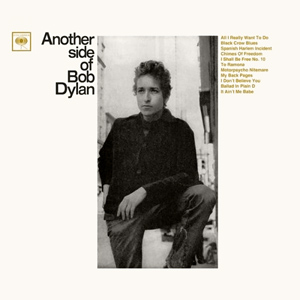
Recorded in just one long, drink-fuelled session, this is Dylan finally telling his legion followers who treated him as a political leader of some sort to bugger off. As the title suggests, this is showing off his various “sides” — romantic, playful, silly, and even selfish and resentful. “Spanish Harlem Incident” is one of the great overlooked Dylan songs, an almost perfect love song. “To Ramona” is also a classic, and “Chimes of Freedom” is one of his better political songs. The surrealism continues on “I Shall Be Free No. 10” and “Motorpsycho Nightmare”. However, there are two real stinkers on this, and two of my least favourite Dylan songs: “My Back Pages” and “Ballad in Plain D”. The latter is ever so dreary and it drags the second the half of this enjoyable album down. The last track saves the day though, “It Ain’t Me Babe” is one of the best songs Dylan would ever write. As a straight break-up song it’s full of devastating lines. But of course the song has the dual function of telling his followers that he’s not the political leader they are looking for. Just the first of many times that Dylan would appear to turn his back on his fans.
Rating: ****3/4
Bringing It All Back Home (1965)
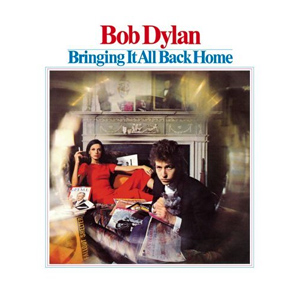
My de facto favourite album by anyone for over a decade now. This is his first album to include an electric side and the cries of “Judas” from the folk purists in the tour that followed are now the stuff of legend. “Subterranean Homesick Blues” and “Maggie’s Farm” shift Dylan’s writing from the political to the social. “She Belongs to Me” and “Love Minus Zero” are textbook examples of near-perfect economic writing, the latter arguably in the top 5 songs he would write, it is a masterpiece. Then there’s a sort of break in the album — some obligatory (and welcome) blues numbers and another surreal adventure in “Bob Dylan’s 115th Dream”. From there the final four acoustic songs are as good as any four songs found in sequence on any album, and probably better. They are notable for how DIFFERENT each of them are as well. “Mr. Tambourine Man” feels like an ode to weed as its images swirl and bore their way into your mind. “Gates of Eden” is stately, majestic, almost pompous, but surreal and almost self-mocking all at the same time, one of his more underrated songs in my view and probably the apex of his tendency towards unlikely and complex images in this period of his songwriting. “It’s Alright Ma” is a song for the ages, with its audacious AAAAAB CCCCCB DDDDDB stanzaic structure and its many quotable lines …
he not busy being born is busy dying
Even the president of the United States / Sometimes must have to stand naked
Advertising signs they con
You into thinking you’re the one
That can do what’s never been done
That can win what’s never been won
Meantime life outside goes on
All around you
For them that must obey authority
That they do not respect in any degree
Who despise their jobs, their destinies
Speak jealously of them that are free
Cultivate their flowers to be
Nothing more than something they invest in
While money doesn’t talk, it swears
When I first heard this song at 18 it just blew my mind. It continues to blow my mind now. There are weak lines here and there, but it feels like the greatest song ever written whenever I hear it. Absolutely fantastic. The fact that it’s probably not as strong as “Love Minus Zero” or the final song of this album, another devastating break-up song, “It’s All Over Now Baby Blue” — probably the best break-up song ever written — tells you everything you need to know about this album. I couldn’t praise it more if I tried. It’s an album that is so good, I’ve come to the point where I believe it justifies its own filler (the blues numbers and the dream track), you almost need a break from hearing songs this exquisitely crafted and so passionately performed.
Rating: *****
Highway 61 Revisited (1965)
This album showcases Dylan at his angriest and most vital. Some of the nastiest and most contemptuous songs ever written are on here, such as “Like a Rolling Stone” (which is often considered the best song ever written), “Queen Jane Approximately” and “Ballad of a Thin Man”. Where Dylan’s playfulness on an album like Another Side Of … is a young man messing about, here his playfulness is always laced with sneering sarcasm and the sort of punkish rebelliousness he hadn’t shown before. “God said to Abraham, “Kill me a Son” / Abe said ‘Man, you must be puttin’ me on”. 7 out of the 9 songs here are bona-fide masterpieces. “Tombstone Blues” is the apotheosis of the arc of surreal songwriting he mined on the acoustic half of the previous album, “Desolation Row” is inarguably his best “epic” track, even “From a Buick 6” is better than the average “blues throwaway filler” track from this period. He’s at the peak of his creative powers here, where he can just throw out a verse like this like it was nothing:
When you’re lost in the rain in Juarez
And it’s Eastertime too
And your gravity fails
And negativity don’t pull you through
Don’t put on any airs
When you’re down on Rue Morgue Avenue
They got some hungry women there
And they really make a mess outta you
But the strength and maturity of the writing only tells one half of the story. His performances here are by-turns snarling, viscous, arch, fed-up, bileful, and remorseless. This has got to be the ultimate album for any young man who feels like he’s just had enough of the world. The only way this album could be better is if the single “Positively 4th Street” had been included.
Rating: *****
Blonde on Blonde (1966)
Dylan sounds markedly wearier on this album than it’s fiery predecessor. This is him in his coffee-fuelled, coked-out “hipster poet” phase. His voice sounds deeper and more strained. And the music has a sound all of its own, as Dylan himself once described it: “that thin, that wild mercury sound. It’s metallic and bright gold.” It’s bluesier than Highway 61 and it traverses a wider range of emotions. Some of the songs here are exquisite: “Visions of Johanna” and “I Want You” with their swirling imagery and beautifully poetic lines are contenders for his best, “One of Us Must Know” and “Most Likely You Go Your Way and I’ll Go Mine” are very good entries into the pantheon of great Dylan breakup tracks, all of the songs demonstrate someone still — as with the last album — at the peak of his powers. However, I find myself listening to this one less than his other classic albums. Why? First is the length. This was one of the first “4-sided” LPs. I find the album drags from “Temporary Like Achilles” onwards. Second, I am really not a fan of the 11-minute “Sad Eyed Lady of the Lowlands”. Make no mistake though, this is one of his absolute best albums, so you should make your own mind up about it. It’s the one that has never quite clicked with me, but I still love it.
Rating: *****
John Wesley Harding (1967)
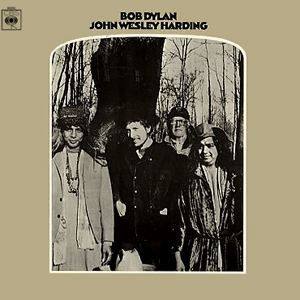
Bob had a much-publicized motorcycle accident after Blonde on Blonde came out in which some say he almost died. Some people at the time thought he might not make another album, until the extent of his injuries were known. Musically and artistically, Dylan was on the monster run of all monster runs, with every album since Freewheelin’ hailed as a masterpiece by music fans in the know and critics (NB. folk purists hated everything after Another Side Of …) and regularly charting in the top 10. His direction until now had been towards ever-increasing complexity. So a grand total of zero people on earth could have predicted he would come out of his post-accident retreat with this quiet, minimalist, stripped-down album of songs that sound like they come from a by-gone age. Most of the songs, with the exception of “The Ballad of Frankie Lee and Judas Priest”, are over in 3 short verses, unusually for a rock album, rhymed AB.
John Wesley Harding
Was a friend to the poor A
He trav’led with a gun in ev’ry hand B
All along this countryside
He opened many a door A
But he was never known
To hurt an honest man B
You’ve got a harmonica, Bob’s vocal, a bass, a steel guitar and an acoustic guitar. That’s it.
This is an exercise in amazingly economic song writing, the sort of which he hinted at on Bringing It All Back Home with “She Belongs to Me” and “Love Minus Zero”. “All Along the Watchtower”, The Wicked Messenger”, “I Dreamed I Saw St. Augustine” and the title track are all exemplary of this. The songs have an obliquely Biblical feel and sound. There is only one eminently skippable track here, “Dear Landlord” – a lament at his manager Albert Grossman – that is too dreary for me to sit through. John Wesley Harding is probably one of the “coolest” albums ever recorded. Quiet, restrained, enigmatic, unusual, profound-sounding, remote, oddly archaic, it always feels like you are the only person on earth to be listening to it. The final two tracks are more country-tinged and hint towards what was to come around the corner. This is one of my favourites.
Rating: *****
Nashville Skyline (1969)
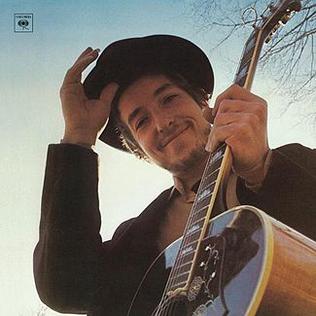
While a turn towards country is hinted at on the final two tracks of John Wesley Harding, few could have predicted a fully-fledged country album replete with a new “crooner” voice in 1969. While the most striking thing about this album is the change in the sound, this signals a new turn towards simplicity and away from the complexity of his “holy trinity” of the mid-60s. While John Wesley Harding has that stripped-down, stark economic song-writing, there’s still quite a dense layering of imagery there. Here, Dylan starts writing incredibly simple, earnest love songs. There are five tight and great songs in this mode here: “To Be Alone With You”, “I Threw It All Away”, the great single “Lay Lady Lay”, the strikingly sincere “Tell Me That It Isn’t True”, and “Tonight I’ll Be Staying Here With You”. These songs feel effortless and easy but they are never schmaltzy or too saccharine; Paul McCartney spent a massive chunk of his solo career in this sort of territory and I’m not sure if he ever managed to get the balance as pitch perfect as Dylan manages here. Then there are light, silly, fun numbers like “Nashville Skyline Rag”, “One More Night” and “Country Pie”. The only real dud here is the superfluous version of Freewheelin’s “Girl From a North Country” with Johnny Cash, which is not the knock-out team up for which you’d hope. People who are not into Dylan have some odd preconceptions about him: he’s serious, he can’t sing, he’s always political – all of that is total crap. The truth is that Dylan gives you a song for every mood, every occasion, and almost every stage of your life. This album is like a comforting hug and silly smile; it’s relaxed and cosy. You can look at other “serious” greatest-of-all-time type artists and a lot of them will be too caught up with perceptions of cool or their own legacy to offer up something like this. Can you imagine Leonard Cohen making this album? Or Lou Reed? Or David Bowie? Or even Neil Young? None of them have a Nashville Skyline. But do you know what? This is as much an important part of life as anything else, and why not? Nashville Skyline completes a run of albums that arguably has yet to be matched by anyone. This album is routinely given five stars by critics, and my rating is no different.
Rating: *****
Next up: The 70s

